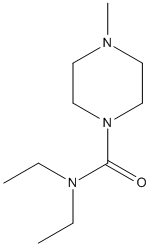Diethylcarbamazine
Weak inhibitor of ChE antihelminthic drug Diethylcarbamazine blocks host, and possibly parasite, enzymes (lipoxygenase) involved in arachidonic acid metabolism. Used primarily as the citrate in the treatment of filariasis, particularly infestations with Wucheria bancrofti or Loa loa.
General
Type : Piperazine,Anthelmintic,Not A\/B H target,Carboxamide
Chemical_Nomenclature : N,N-Diethyl-4-methyl-1-piperazinecarboxamide
Canonical SMILES : CCN(CC)C(=O)N1CCN(CC1)C
InChI : InChI=1S\/C10H21N3O\/c1-4-12(5-2)10(14)13-8-6-11(3)7-9-13\/h4-9H2,1-3H3
InChIKey : RCKMWOKWVGPNJF-UHFFFAOYSA-N
Other name(s) : Carbamazine,Carbilazine,Bitirazine,Banocide,Caracide,Caricide,Ethodryl,Notezine,Spatonin,Ditrazine Base,Dicarocide,Caritrol,Eosinopin,Filazine,Franocide,Franozan,Hetrazan,Loxuran,Carbam Palatabs,Ethodryl citrate,Diethyl carbamazine
MW : 199.30
Formula : C10H21N3O
CAS_number : 90-89-1
PubChem : 3052
UniChem : RCKMWOKWVGPNJF-UHFFFAOYSA-N
IUPHAR :
Wikipedia : Diethylcarbamazine

Target
References (9)
| Title : Modes of action of anthelmintic drugs - Martin_1997_Vet.J_154_11 |
| Author(s) : Martin RJ |
| Ref : Vet J , 154 :11 , 1997 |
| Abstract : Martin_1997_Vet.J_154_11 |
| ESTHER : Martin_1997_Vet.J_154_11 |
| PubMedSearch : Martin_1997_Vet.J_154_11 |
| PubMedID: 9265850 |
| Title : Effect of diethylcarbamazine on acetylcholine and gamma amino butyric acid in Setaria digitata - Vijayanathan_1992_Indian.J.Exp.Biol_30_920 |
| Author(s) : Vijayanathan L , Raj RK |
| Ref : Indian J Exp Biol , 30 :920 , 1992 |
| Abstract : Vijayanathan_1992_Indian.J.Exp.Biol_30_920 |
| ESTHER : Vijayanathan_1992_Indian.J.Exp.Biol_30_920 |
| PubMedSearch : Vijayanathan_1992_Indian.J.Exp.Biol_30_920 |
| PubMedID: 1293019 |
| Title : In vitro and in vivo effect of diethylcarbamazine on the activity of acetylcholinesterase from Wuchereria bancrofti infected human serum - Misra_1992_Trop.Med.Parasitol_43_95 |
| Author(s) : Misra S , Taneja V , Rathaur S |
| Ref : Trop Med Parasitol , 43 :95 , 1992 |
| Abstract : Misra_1992_Trop.Med.Parasitol_43_95 |
| ESTHER : Misra_1992_Trop.Med.Parasitol_43_95 |
| PubMedSearch : Misra_1992_Trop.Med.Parasitol_43_95 |
| PubMedID: |
| Title : Efficacy of diethylcarbamazine and pirimiphos-methyl residual spraying in controlling brugian filariasis - Chang_1991_Trop.Med.Parasitol_42_95 |
| Author(s) : Chang MS , Ho BC , Chan KL |
| Ref : Trop Med Parasitol , 42 :95 , 1991 |
| Abstract : Chang_1991_Trop.Med.Parasitol_42_95 |
| ESTHER : Chang_1991_Trop.Med.Parasitol_42_95 |
| PubMedSearch : Chang_1991_Trop.Med.Parasitol_42_95 |
| PubMedID: 1680246 |
| Title : Diethylcarbamazine: inhibitory effect on acetylcholinesterase of Dirofilaria immitis and Brugia pahangi - Fujimaki_1989_Southeast.Asian.J.Trop.Med.Public.Health_20_179 |
| Author(s) : Fujimaki Y , Sakamoto M , Shimada M , Kimura E , Aoki Y |
| Ref : Southeast Asian J Trop Med Public Health , 20 :179 , 1989 |
| Abstract : Fujimaki_1989_Southeast.Asian.J.Trop.Med.Public.Health_20_179 |
| ESTHER : Fujimaki_1989_Southeast.Asian.J.Trop.Med.Public.Health_20_179 |
| PubMedSearch : Fujimaki_1989_Southeast.Asian.J.Trop.Med.Public.Health_20_179 |
| PubMedID: 2609206 |
| Title : Pharmacological analysis of the neuromuscular properties of diethylcarbamazine citrate in vitro - Ojewole_1984_Methods.Find.Exp.Clin.Pharmacol_6_91 |
| Author(s) : Ojewole JA |
| Ref : Methods Find Exp Clin Pharmacol , 6 :91 , 1984 |
| Abstract : Ojewole_1984_Methods.Find.Exp.Clin.Pharmacol_6_91 |
| ESTHER : Ojewole_1984_Methods.Find.Exp.Clin.Pharmacol_6_91 |
| PubMedSearch : Ojewole_1984_Methods.Find.Exp.Clin.Pharmacol_6_91 |
| PubMedID: 6717175 |
| Title : Effects of selected cholinergic and anticholinergic drugs on Brugia malayi (Nematoda) - Hillman_1983_Comp.Biochem.Physiol.C_74_299 |
| Author(s) : Hillman GR , Ewert A , Westerfield L , Grim SO |
| Ref : Comparative Biochemistry & Physiology C , 74 :299 , 1983 |
| Abstract : Hillman_1983_Comp.Biochem.Physiol.C_74_299 |
| ESTHER : Hillman_1983_Comp.Biochem.Physiol.C_74_299 |
| PubMedSearch : Hillman_1983_Comp.Biochem.Physiol.C_74_299 |
| PubMedID: 6133685 |
| Title : Effect of diethylcarbamazine on Wuchereria bancrofti microfilarial enzymes - |
| Author(s) : Chandrasekaran B , Ghirnikar SN , Harinath BC |
| Ref : Indian J Biochem Biophys , 18 :139 , 1981 |
| PubMedID: 6118325 |
| Title : Anticholinesterase activity of piperazine derivatives. Study of the structure-activity relationship in piperazine derivatives measured by the potentiation of acetylcholine response in Ascaris suum - |
| Author(s) : Natarajan PN , Yeoh TS , Zaman V |
| Ref : Acta Pharm Suec , 10 :125 , 1973 |
| PubMedID: 4728098 |